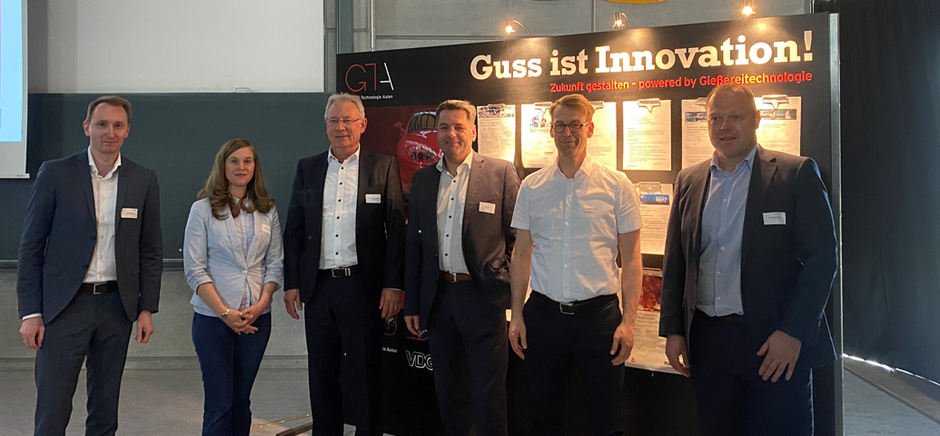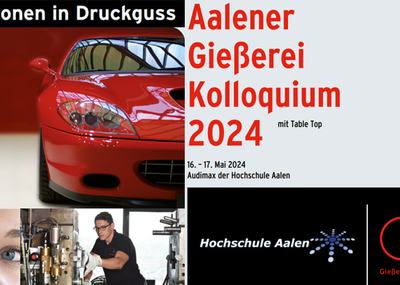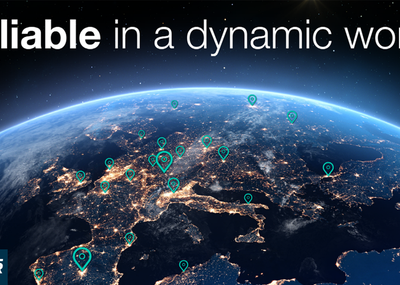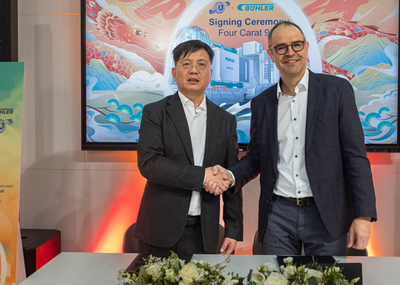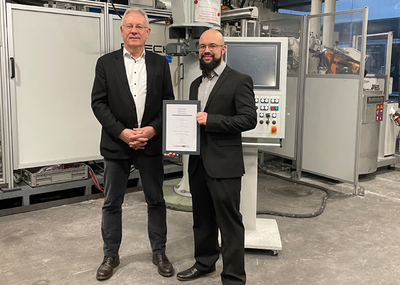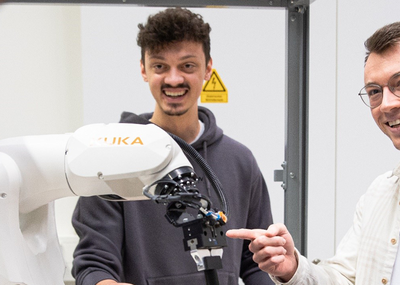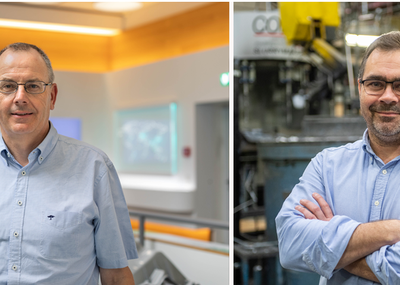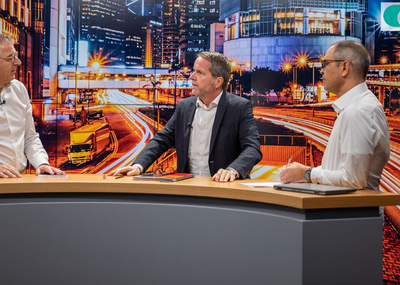Prof. Harald Riegel, Rector of Aalen University, opened the first speech session by welcoming the participants from industry and research. After that, Prof. Lothar Kallien presented the German university ranking under the motto "Research Strong University". In the DFG Funding Atlas, the University of Aalen was ranked first in Germany in research.
Highly Integral Lightweight Components for E-Mobility
The first session was held by Dipl.-Ing. Klaus Sammer and Dr. Thomas Kopp from BMW AG in Landshut, who spoke about "Intelligent lightweight construction through the use of cast components". With the motto "The right material in the right place", a component was used to show that high wall thicknesses, required for mould filling, are counterproductive for crash-relevant large cast components. By joining a sheet in these areas, the lightweight potential can be optimally used, and the vehicle frame can be produced on an existing die-casting machine. Using printed sand cores, the BMW AG representatives demonstrated that the central electric drive train, which absorbs torques of up to 760 Nm, can be manufactured as "single pieces" by injector casting. This enables functionally highly integral lightweight components for e-mobility with maximum strength.
New opportunities in times of transformation
Dipl.-Ing. Mirco Wöllenstein, Foundry Manager at Volkswagen AG in Kassel, spoke about "New developments and new challenges at Volkswagen". The entire foundry industry is confronted with risks such as multiple crises, competitive pressure and a shortage of qualified personnel. At the same time, new opportunities arise in times of transformation through innovative products and processes as well as high-performance teams and digitalisation. The production of large castings on existing die casting machines for body construction enables the substitution of assemblies from numerous individual parts. Considering innovative process technologies, the component weight, costs, and throughput times in vehicle construction can be reduced. Environmental issues are being tackled at the foundry in Kassel with a "goTOzero strategy". The use of secondary aluminium and green hydrogen in the remelting plant, from the largest electrolyser currently under construction, will make an immense contribution to reduce the CO2 footprint in the manufacturing of products in the years ahead.
The goal is to produce climate neutrally by 2039
Dr. Katharina Faerber and Dipl.-Ing. Denis Hopp from Handtmann spoke about "Alloys and sustainability: innovation in die casting". The goal is to produce climate-neutrally by 2039. Primary aluminium alloys have the highest impact, with 6.8 kg CO2 per kg (EU average) to produce structural and chassis components. By using secondary aluminium with a recycled content of 90%, the CO2 footprint can be reduced to less than 1 kg CO2 per kg aluminium. The presenters outlined a joint research project with Aalen University in which alloys were investigated with an increased recycled content. Another approach to decarbonisation at Handtmann is lightweight construction. This requires topology and structural optimisation of components, and thus intensive cooperation with OEMs. For economic sustainability, the megatrends, and their influence on the foundry industry must be known. Relevant trends for Handtmann are globalisation, e-mobility, decarbonisation, and artificial intelligence. The challenge here is to focus on the right technology to ensure long-term protection and strengthening of the market position in the future.
TANDEM casting of structural components in die casting
Dipl.-Ing. Roberto Trevisan from Vetimec presented an innovative tool concept with the title "TANDEM casting of structural components in die casting: a concrete example". To produce structural components, a very high clamping force is required to compensate for the high casting pressures in large-area die-cast components. A new approach by the company Vetimec shows that two components can be produced simultaneously on one machine. The clamping force is not doubled in the process. In the presentation, this was demonstrated on a concrete component, in which a punching process takes place in the mould itself to separate the sprue system of the second cavity. In cooperation with the company Bühler, the implementation of such mould concepts for GIGA die casting systems is planned.
Rheocasting and die casting for lightweight construction
The company SAG Innovation GmbH, represented by M.Sc. Fabian Hofstätter, introduced the topic "Rheocasting and die casting for lightweight construction". The advantage of rheocasting, which requires upstream process steps compared to die casting, is the laminar flow due to thixotropic properties. Based on a selection of components, it was shown that the process can reduce porosity compared to classic die casting. Another advantage is the lower temperature of a semi-solid melt, which has a positive effect on tool life, wall thickness distribution and shrinkage.
After brief lectures by the exhibitors, there was the opportunity for an intensive personal exchange during the foundry evening in the laboratory at Aalen University. Numerous visitors from the foundry and supplier industry took this opportunity to discuss current topics.
On Friday morning, Prof. Dr.-Ing. Lothar Kallien welcomed the auditorium to the second day of the Aalen Foundry Colloquium. Dr. Achim Keidies from BDGuss informed the audience in his lecture about the activities of BDGuss in the field of die casting. In 2022 the approximately 70,000 employees of the German foundry industry generated a turnover of around 14 billion euros, which is an increase of 19 % compared to the previous year.
Based on a capacity utilisation of 85 % and a range of order backlogs of slightly more than five months, the order situation of the existing foundries is good.
Wollin EcoSpray: "Less is more, even less is better".
In his presentation, Martin Lutz introduced Wollin GmbH's products, especially for gigacastings, on the one hand, and minimum quantity spraying (MQL) for die casting on the other. The guiding principle "Less is more, even less is better" characterises the variants of the Wollin EcoSpray, which reduces the application of release agent from more than one litre to a few millilitres per casting cycle. In addition to the reduced spray mist impact on the employees' working environment, a 100% reduction in wastewater caused by the application of release agent, as well as a shortening of the spraying cycle time and a reduction in the temperature difference before and after the spraying process have to be emphasised.
In the GISS technology (Gas Induced Superheated Slurry) presented by Tommaso Botter (Mambretti Tech), thinly spread nuclei are produced in the aluminium melt immediately before casting. This is achieved by introducing nitrogen gas bubbles. The casting temperature of the superheated slurry is significantly lower than the conventional casting temperature. The increased solid phase content of the slurry results in improved mould filling conditions and replenishment conditions, whereby the proportion of gas and shrinkage porosity in the die-cast part is reduced even at low holding pressure.
Savings potentials through innovative release agent technology
Dr.-Ing. Jochen Caster (Quaker Houghton Sales B.V.) showed potential savings in terms of energy, raw materials, and costs through innovative release agent technology. The water-free mould release agent Lubrolene can be used in a wide temperature range and is applied by an electrostatic spray process. The electrostatic wrap-around effect achieves an optimum surface wetting at a spray pressure of less than one bar. With a single nozzle, a larger area is covered even with a complex mould geometry than with a nozzle in conventional minimum quantity spraying. This is particularly advantageous for ribs and side wall sections.
Finally, the foundry laboratory staff provided information on the status of current research and development topics.
Christos Mangos presented the problem of hydrogen input in the coating of zinc die-cast components. During the project period of the ZiBe3 project (AiF/IGF project no. 22574 N/2), the difficulty must be deeply analysed, and the casting and coating process must be optimised accordingly.
Max Schütze, in contrast, spoke about the use of multi-layer sand cores in die casting. The project, which is funded by the German Research Foundation (DFG - 505145110), is carried out in cooperation with the utg of the TU Munich.
Producibility of hybrid components made of CFRP in the die casting process
Daniel Schwarz presented the contents of his PhD project on the manufacturability of hybrid components made of CFRP using the die casting process. As part of the InDimat project (Innovative joining processes and stress-appropriate design concepts for hybrid lightweight CFRP multi-material composites; BMBF-FKZ: 03FH4I03IA), Schwarz investigated the joint strength of CFRP in aluminium and magnesium die casting as a function of the casting wall thickness and insert geometry as well as the corrosion properties of the joint. Currently, efforts are being made to further develop the process with encapsulated wooden structures.
Max Schütze informed about the Indrutec-E project (BMWi-FKZ: 03LB2004A), which focuses on lightweight construction, alloy, and process development in die casting. The main component of the project is the comparison of mechanical characteristics of components, which were produced in different die casting processes with primary and secondary alloys.
Thomas Weidler spoke about the development and advantages of fibre-reinforced magnesium components in die casting (Magweb, ZIM-FKZ: ZF4113814DE8). By using different fabrics, the yield strength and elongation at break were affected.
Christos Mangos presented the project of Zynk-Guss (AiF/IGF-project no. 29100 N) for the analysis of the cyclic material performance for the evaluation of modern zinc die casting alloys for cyclically highly stressed components. As part of the project, the data basis and a design concept for cyclically stressed components are to be determined.
Florian Mäuser spoke about the status of the European Union-funded Fast Track to Innovation project MAGIT (H2020-EIC-FTI-2018-2020, Grant Agreement Number: 950866). Gas injection technology in die casting allows producing hollow structures in the die casting process for media conduction and for the implementation of integrative lightweight design. The recently developed gas injection technology makes it possible to use it in an industrial environment.
The final lunch in the foundry laboratory of Aalen University once again offered the chance for an intensive professional exchange on the topics of the presentations.

